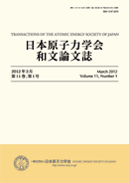
- Issue 4 Pages 101-
- Issue 3 Pages 64-
- Issue 2 Pages 50-
- Issue 1 Pages 1-
- |<
- <
- 1
- >
- >|
-
Hideo TANAKA, Kenta MURAKAMI2024Volume 23Issue 3 Pages 64-73
Published: 2024
Released on J-STAGE: August 23, 2024
Advance online publication: August 08, 2024JOURNAL FREE ACCESS FULL-TEXT HTMLIncentives for decision-makers to continue investing resources in the safety improvement of the existing nuclear fleet are studied. On the basis of a broad survey of studies related to decision-making, two approaches are selected: one is the seven-step process to identify the “red flag” that makes a decision-maker biased and the other is to have a risk management system outside the organization, the so-called “forum for deliberation”. These were hypothetically applied to a case study on tsunami countermeasures; the results suggested that they were effective to a certain degree. These mechanisms are considered to be a booster when trying to maintain human resources related to safety improvement without reducing resources, even in a difficult business environment. The implementation of these approaches in consideration of the current organizational structure is discussed.
View full abstractDownload PDF (1555K) Full view HTML -
Development of Behavior Analysis Code for MA Transmutation Nitride Fuel in Accelerator-Driven SystemHiroki SHIBATA, Hiroaki SAITO, Hirokazu HAYASHI, Masahide TAKANO2024Volume 23Issue 3 Pages 74-80
Published: 2024
Released on J-STAGE: August 23, 2024
Advance online publication: August 08, 2024JOURNAL FREE ACCESS FULL-TEXT HTMLPartitioning and transmutation techniques for minor actinides have been developed to reduce the radiotoxicity and volume in high-level radioactive wastes. Minor actinide nitride fuel has been chosen as a candidate for the transmutation of long-lived nuclides using an accelerator-driven system. Understanding the irradiation behavior of nitride fuel is important for its design and development; however, experimental data on irradiation tests of actinide nitrides and their solid solutions are scarce. Recently, in JAEA, a nitride fuel performance analysis module based on the light water reactor fuel performance code FEMAXI-7 has been developed to simulate the irradiation behavior of the nitride fuel. In this study, performance analysis was carried out focusing on the pellet-cladding mechanical interaction (PCMI), which was pointed out as the most effective factor in fuel safety during irradiation. Simulation results show that PCMI does not cause the creep rupture of the cladding.
View full abstractDownload PDF (2344K) Full view HTML -
Toshihiro OKUYAMA2024Volume 23Issue 3 Pages 81-100
Published: 2024
Released on J-STAGE: August 23, 2024
Advance online publication: August 08, 2024JOURNAL FREE ACCESS FULL-TEXT HTML
Supplementary materialIn this study, the perceptions of Tokyo Electric Power Company employees and executives concerning tsunami risk at the Fukushima Daiichi Nuclear Power Station during the years 2008 to 2009, predating the 2011 accident at the facility, are investigated. Newly available court records and other investigative materials are utilized. The findings of this study reveal significant disparities in the perceptions of individuals within the TEPCO organization during the period of interest regarding the risk of tsunami hazards in Fukushima. The perception of tsunami risk and the level of support for long-term evaluation by a government panel, which indicated a high likelihood of a tsunami earthquake near the Japan Trench off the Fukushima coast, exhibited an inverse relationship with one's position within the corporate hierarchy. The employee who held the lowest position in the company was the most concerned about the risk, while those in higher positions were less concerned. This trend can be comprehensively explained by the theory of cognitive dissonance and various biases including affiliation bias, status quo bias, and non-expertise avoidance bias.
View full abstractDownload PDF (893K) Full view HTML
- |<
- <
- 1
- >
- >|